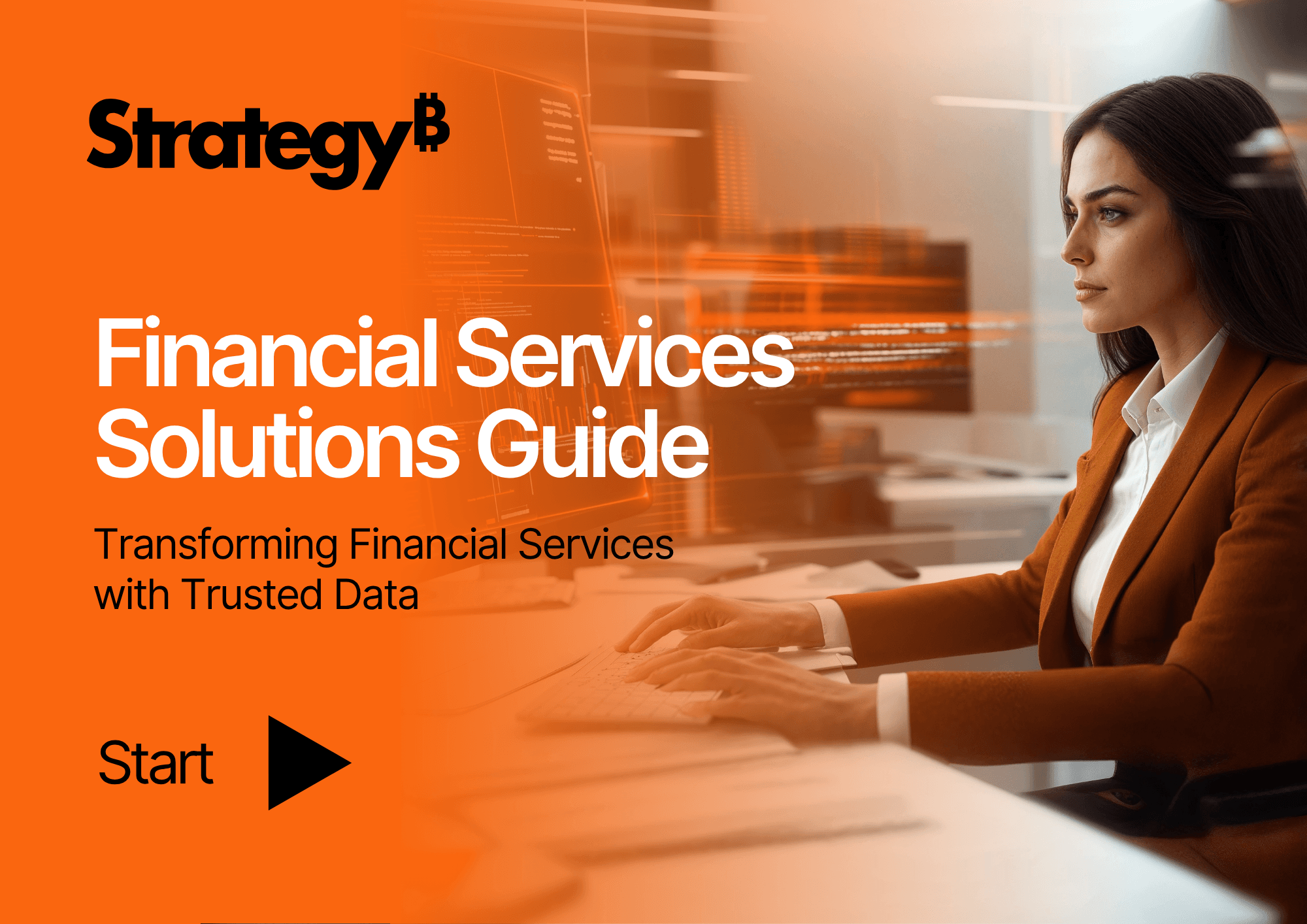4 Use Cases for FSI Leaders Transforming Analytics
Modern financial institutions know that the ability to make fast, data-informed decisions is no longer a competitive edge—it’s a requirement. However, delivering timely insights across hundreds or thousands of users while ensuring consistency and compliance is no easy feat.
The challenge isn’t a lack of data.
It’s siloed systems, inconsistent definitions, governance gaps, and slow adoption.
How are leading banks, insurers, lenders, and fintech firms solving these problems?
By turning analytics into a strategic asset with Strategy One.
See how industry leaders are transforming analytics.
Get the Financial Services Solutions Guide.
Here’s a preview of the four most common use cases—and how real companies are delivering results.
1. Building a Data Foundation for a Single Source of Truth
Before you can scale AI, automation, or self-service, you need reliable, unified data.
For many financial organizations, that starts with consolidating data silos and standardizing metrics.
Alabama Ag Credit, a regional lender serving 8,000 clients, replaced more than 30 legacy reports with a single, real-time dashboard tied to incentive compensation.
The result? Credit analysis that once took eight people five days now takes just two people 30 minutes—a 300x workload reduction.
Similarly, Enova International, a digital lender serving 12 million customers, faced a sprawl of tools: Tableau, Excel, Python, and more. The real problem? Different teams were using different versions of the same KPIs.
By standardizing data models and migrating core reporting to Strategy One, Enova enabled real-time Slack alerts, unified dashboards, and consistent performance reviews across the enterprise.
2. Operationalizing Intelligence with a Semantic Layer
Once the data foundation is in place, organizations can scale insights further using semantic layers—governed business logic that enables consistency across roles, tools, and workflows.
Fannie Mae used Strategy’s semantic layer to expose certified risk and treasury data via APIs, enabling real-time forecasting in high-stakes trading decisions. With data-as-a-product principles and strict role-based access, they replaced spreadsheets and macros with trusted, governed metrics.
Banco Hipotecario, one of Argentina’s largest lenders, transitioned from Power BI to Strategy One after uncovering gaps in interactivity and governance. With a semantic layer in place, the bank rolled out AI-powered dashboards and conversational interfaces to help managers forecast trends and make faster decisions—without needing SQL or manual reports.
3. Strengthening Governance & Compliance
In banking and insurance, governance isn’t optional—it’s critical. Leading firms are proactively establishing control over their KPIs, data access, and audit trails to ensure regulatory compliance.
goeasy, a non-prime lender in Canada, developed a full “BI Center of Excellence” to eliminate KPI confusion across business units. However, a single enterprise KPI had seven competing definitions—leading to executive-level meetings where no one agreed on the numbers. Today, goeasy has a certified master list, 2,200 governed users, and 93% of reports that are fully standardized.
Sava Insurance, Slovenia’s second-largest insurer, built a live, dynamic data dictionary to eliminate redundant tables, simplify onboarding, and prepare for cross-subsidiary consolidation. In the first year alone, the initiative saved €80K and 500 TB of unnecessary storage.
4. Driving Adoption & Efficiency at Scale
Even the best dashboards fail without engagement. High-impact FSI teams embed analytics directly into workflows—delivering insights to the right people in the right format at the right time.
Renasant Bank launched “READY,” a bank-wide ecosystem of role-based dashboards and mobile insights tailored to job function. With HyperCards and embedded CRM access, employees across lending, mortgage, and wealth are now equipped with daily operational KPIs.
Amica Mutual Insurance empowered claims and sales teams with real-time access to upsell opportunities. The result? $480K in new revenue through targeted umbrella policies. Moreover, 90% of claims leadership used the governed dashboards every day.
Prisma Medios de Pago, a payments leader in Argentina, built an AI-powered assistant to surface client trends in seconds—equipping sales reps to walk into every meeting with data-backed recommendations.
See the Full Guide: Trusted Data in Action
These are just a few of the many stories shared in the Financial Services Solutions Guide.
From data foundations to semantic layers, governance, and adoption, each story highlights how institutions are rethinking analytics to meet rising demands across the business.
Whether you're modernizing infrastructure, preparing for AI, or just trying to eliminate reporting sprawl, there’s something in this guide for every FSI leader.
Read the Financial Services Solutions Guide.


